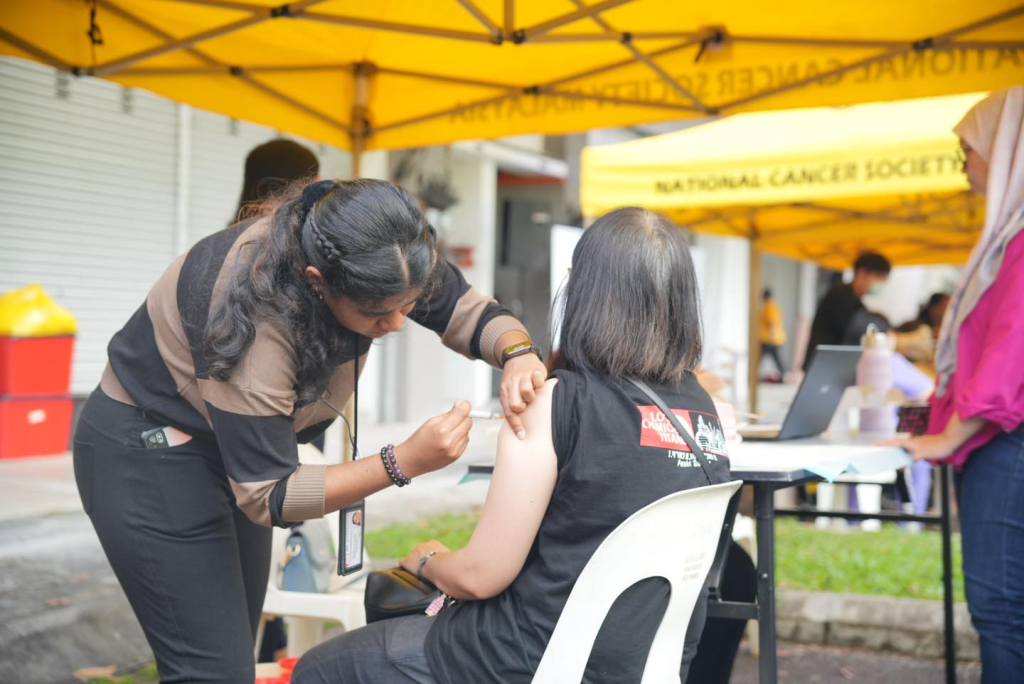By Dr Leevyadhashiny Ganasan, Medical Officer and Health Promotion Lead, NCSM,
The age-standardised incidence rate of cervical cancer in Malaysia is 10.2 per 100,000 women, which is lower than the global rate of 14.1 but higher than the rate in high-income countries, which stands at 7.5 per 100,000.

The uptake of cervical cancer screening, such as Pap smear in Malaysia has remained alarmingly low at around 35.2% of eligible women participating despite the availability of free screening since 1995. [5] This has only further proven the significant public health challenge cervical cancer has posed in Malaysia, particularly among underprivileged communities.
The WHO recommends that women aged 30–49 undergo regular cervical cancer screening using HPV DNA test or Pap smear [6]. The HPV DNA test detects high-risk types of Human Papillomavirus (HPV) associated with cervical cancer, offering higher sensitivity and earlier detection compared to the Pap smear, which identifies cellular abnormalities in the cervix caused by persistent HPV infection [6].
Both tests play crucial roles in prevention: the HPV DNA test is more effective for identifying women at risk before cellular changes occur, while the Pap smear can detect existing abnormalities for timely intervention [6]. Screening should begin at the age of 30, with intervals of 5–10 years for HPV DNA testing or more frequent intervals for Pap smears, depending on resources and risk factors [6]. Expanding access to screening and follow-up care is critical to reducing cervical cancer incidence and mortality globally.
Uneven Healthcare Infrastructure
A study by Abdullah et al. (2010) emphasises the importance of opportunistic cervical cancer screening in Malaysia, particularly in light of the nation’s persistently low uptake rates despite the availability of services. Opportunistic screening, conducted during routine healthcare visits, provides an avenue to increase early detection rates by targeting women who may not actively seek screening.
However, the study also highlights several weaknesses and barriers within the current screening programs, including limited public awareness, cultural and social stigmas, and inadequate accessibility to screening facilities [1]. Additionally, the reliance on opportunistic screening rather than systematic population-based screening leads to inconsistencies in coverage and follow-up care [1].
A pressing barrier to cervical cancer screening in Malaysia is the uneven healthcare infrastructure. Rural areas often lack adequate healthcare facilities and trained personnel, resulting in long waiting times for services.
Women in these regions may find it difficult to access screening due to the geographical distance from healthcare centers, compounded by a shortage of smear-readers necessary for processing tests [1][2]. This disparity creates a significant gap in health equity, where urban women have far greater access to screening services than their rural counterparts.
Adding to the existing challenges is also the lack of awareness and information regarding cervical cancer and the importance of regular screening. Many women are not adequately informed about their eligibility for free services or the risks associated with cervical cancer.
Awareness campaigns primarily utilise mass media rather than targeted outreach that could effectively reach underserved populations [3]. This lack of personalised communication also leaves many women unaware of their need for screening or how to access these services.
While cervical cancer screening is free in public facilities, indirect costs such as transportation, time off work, and childcare can deter women from attending appointments.
A targeted educational campaign is essential for raising awareness about cervical cancer risks and the critical importance of regular screenings. Such initiatives can significantly improve knowledge and screening uptake, particularly in communities that are often overlooked by traditional health campaigns. In collaboration with local leaders and community organisations, the Leaving No One Behind (LNOB) initiative spearheaded by The National Cancer Society of Malaysia (NCSM) for instance has effectively disseminated vital information in local languages, ensuring that women in underserved areas understand the necessity of cervical cancer screenings.
For many underprivileged families, prioritising immediate financial needs over preventive healthcare can lead to neglecting essential screenings [4]. Immigrant women, for instance, often face additional challenges, including language barriers and lack of health insurance coverage for screening services.
Cultural beliefs and social stigma surrounding reproductive health further impede women’s willingness to seek screening. In many communities, discussions about cervical cancer are taboo, leading to misinformation and fear surrounding the procedures involved in screening [1]. Women may feel embarrassed or fearful about undergoing examinations, particularly if they lack support from family or community members.
Enhancing access
The LNOB initiative has made significant strides in enhancing access to essential health services for marginalised communities, particularly in Johor.
This initiative is crucial in the fight against cervical cancer, which remains a pressing health issue in the region. Recent statistics indicate that cervical cancer is the second most common cancer among women in Malaysia, with an estimated incidence rate of 9.1 per 100,000 women in Johor alone.
To address barriers faced by underserved populations, the LNOB initiative has implemented several targeted programs including community engagement and education, mobile health clinics and HPV vaccination campaigns.
To date, NCSM Johor has vaccinated over 22,000 teenage girls against HPV, significantly contributing to the prevention of cervical cancer. This proactive approach not only protects young women but also fosters a culture of preventive healthcare within marginalised communities.
These efforts complement broader strategies outlined in Malaysia’s National Strategic Plan for Cancer Control (2021-2025), which aims to improve screening uptake and reduce mortality rates from cervical cancer. By focusing on marginalised groups, the LNOB initiative plays a pivotal role in ensuring equitable access to health services and ultimately contributes to the reduction of cervical cancer incidence in Johor and beyond.
Partnerships and Collaborations
In Jementah, Segamat, NCSM had the privilege of working alongside YB Ng Kor Sim not once, but twice, on this programme, which highlighted the effectiveness of grassroots approaches.
This collaboration not only demystified cervical cancer screenings but also empowered women to prioritise their health. However, to amplify these efforts, it is crucial for more government officials, like Members of Parliament (MPs) and State Assembly Representatives (ADUNs), to join this initiative. Their involvement can enhance outreach and foster greater community engagement, ultimately leading to increased screening rates.
Regular screenings are vital because they allow for early detection of cervical cancer, which is highly treatable when caught in its initial stages. Educational campaigns can combat misinformation and cultural stigmas surrounding these screenings, encouraging women to take proactive steps in managing their health. By prioritising educational initiatives and engaging government officials at all levels, we can significantly improve cervical cancer awareness and screening uptake in marginalised communities.
The Leaving No One Behind (LNOB) initiative has effectively harnessed the power of public-private partnerships to enhance accessibility to cervical cancer screenings within underserved communities.
By deploying NCSM’s mobile health trucks, generously sponsored by MCIS Life, essential health services are brought directly to those who need them most. These mobile clinics travel to rural areas, significantly reducing the barriers of travel time and costs associated with accessing healthcare facilities.

A notable instance of this initiative was the deployment of our purple mobile health truck to Kulaijaya, Johor, where NCSM collaborated with the PKD Kulaijaya team during the outdoor health event ‘Karnival Kulai Sihat.’
This event allowed the community to receive vaccinations on-site, demonstrating how mobile health solutions can increase accessibility and encourage participation in preventive healthcare.
The collaboration between LNOB and local healthcare providers, including nearly 10 private clinics in Johor, has been crucial in enhancing service delivery. These clinics volunteered their time and resources, advocating for the LNOB initiative and providing free vaccinations to the community. This public-private partnership not only strengthens the healthcare ecosystem but also builds trust between healthcare providers and communities, encouraging more women to seek screenings.
Only 10 minutes
Moreover, government bodies like LPPKN can further complement this programme by integrating HPV DNA testing into the services offered through these mobile clinics. This can be significantly enhanced by promoting self-swab methods, which empower women to take control of their health. Self-sampling for HPV testing is a minimally invasive procedure that can be completed in just 10 minutes, making it an accessible option for many.

By fostering collaboration among public agencies like LPPKN, private healthcare providers, and community organisations, we can create a comprehensive framework that not only increases cervical cancer screening rates but also ensures that women understand the importance of self-swabbing as a vital step in early detection and prevention of cervical cancer.
By breaking down these barriers, we can ensure that no woman is left behind in accessing vital health services. It is imperative that we act now. Cervical cancer is not just a statistic, it represents real lives affected by preventable disease.
References
- Abdullah F, Aziz NA, Zainuddin AA, Jamil SN, Ramli RR. Enhancement of the cervical cancer screening program in Malaysia: A qualitative study. Asian Pac J Cancer Prev. 2010;11(5):1359–66.
- Institute for Public Health (IPH). National Health and Morbidity Survey (NHMS) 2019: Non-communicable diseases, healthcare demand, and health literacy: Key Findings. Putrajaya: Ministry of Health Malaysia; 2019.
- MIMS Malaysia. Cervical cancer – prevention & screening guideline references. Kuala Lumpur: MIMS Malaysia; 2024.
- Wong LP, Wong PF, Abu Hassan MR, Mohamed F, Aris T. Factors influencing the prevalence of cervical cancer screening in Malaysia. PLoS One. 2023;18(1):e0289361.
- Chan YM, Ismail MZH, Khaw WF. Factors influencing the prevalence of cervical cancer screening in Malaysia: A nationwide survey. BMC Womens Health. 2023;23(1):315.
- World Health Organization. Cervical cancer [Internet]. Geneva: World Health Organization; 2023 [cited 2025 Jan 9]. Available from: https://www.who.int/news-room/fact-sheets/detail/cervical-cancer
- Noor, Omar J. Cervical cancer in Malaysia. Journal of obstetrics and gynaecology research. 2024 Jul 19;





